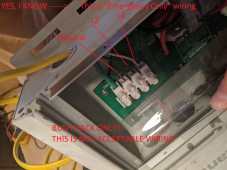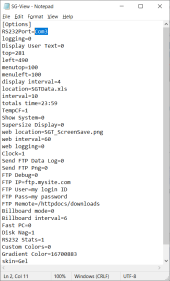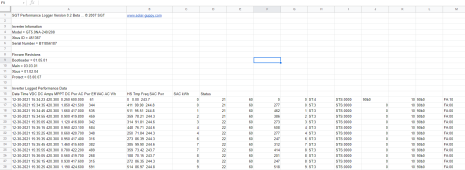You are using an out of date browser. It may not display this or other websites correctly.
You should upgrade or use an alternative browser.
You should upgrade or use an alternative browser.
IoT (cell) uplink for GroWatt SPF 5000ES
- Thread starter methods
- Start date
methods
New Member
- Joined
- Dec 6, 2021
- Messages
- 173
Ok
It worked.
The unit booted up and it is showing that there is no PV input.
Eh... While video uploads I can do one of two things
* Rig up the 600V Power Supply
* Rig up the RS-232 data cable
I IMAGINE that it may go a little better if I have the data rigged up to take screen shots... but.... the information should be on the simple LCD. I think we will KISS and not hook up the data for now.
Strictly Liquid Crystal Display
-methods
It worked.
The unit booted up and it is showing that there is no PV input.
Eh... While video uploads I can do one of two things
* Rig up the 600V Power Supply
* Rig up the RS-232 data cable
I IMAGINE that it may go a little better if I have the data rigged up to take screen shots... but.... the information should be on the simple LCD. I think we will KISS and not hook up the data for now.
Strictly Liquid Crystal Display
-methods
methods
New Member
- Joined
- Dec 6, 2021
- Messages
- 173
Ok, where here is the Recap
* Got the inverter yesterday
* Never touched one of these before in my life
* Pulled it out of the trunk at 3AM
* Knocked together some cables off the floor
* Hooked it up
* It worked
Pretty sweet 24hr turn-around of Proof of non-DOA
-methods
* Got the inverter yesterday
* Never touched one of these before in my life
* Pulled it out of the trunk at 3AM
* Knocked together some cables off the floor
* Hooked it up
* It worked
Pretty sweet 24hr turn-around of Proof of non-DOA
-methods
methods
New Member
- Joined
- Dec 6, 2021
- Messages
- 173
methods
New Member
- Joined
- Dec 6, 2021
- Messages
- 173

Looks like this thing never saw much service. 8MWH in total.
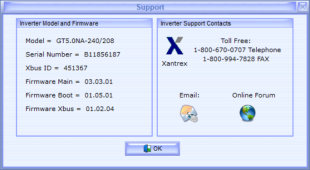
You can change the LCD spill.. no doubt I will set it to say something rude.
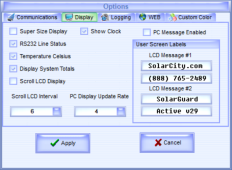
Thoroughly uninteresting, I see no settings so far.

In Practical Use it faults out at 580V, so the 600V is an Electrical ABSMAX, not a maximum running voltage. Manual calls 550V, so that is good.

There it is running up toward the 550V limit. Over a horsepower no matter how you look at it.
... The software is a V2, sort of 3rd party. I was hoping it would at least allow me to fiddle a little this or that. Nada. No visible options to push firmware. This is the "Clown Version" of the software.
-methods
methods
New Member
- Joined
- Dec 6, 2021
- Messages
- 173
I think this is the bulk of the postings
 solar-guppy.com
solar-guppy.com
Ok
I kinda wish I had not bothered, but... logging is nice. At least I can see the format coming out. I will stuff that into an aTiny or Feather and bridge it later. Logging is definitely FTW.
Yea -
Fine
I am tired. If you add 7hrs to 1600 it is 11PM for me. That should be everything that you would want to see before opening one of these things up. It is as Trivial of an install as you could possibly muster. Just RTFM and you should be fine.
Bye
-methods
SG-View For Xantrex GT Inverters
SG-View For Xantrex GT Inverters : SG-View Downloads , Support and Questions
Ok
I kinda wish I had not bothered, but... logging is nice. At least I can see the format coming out. I will stuff that into an aTiny or Feather and bridge it later. Logging is definitely FTW.
Yea -
Fine
I am tired. If you add 7hrs to 1600 it is 11PM for me. That should be everything that you would want to see before opening one of these things up. It is as Trivial of an install as you could possibly muster. Just RTFM and you should be fine.
Bye
-methods
methods
New Member
- Joined
- Dec 6, 2021
- Messages
- 173
One more thought

That is "Recirculating Power"
* AC to DC Lab Supply creating 1hp of DC at 550V
* Grid-Tie taking that in, spitting power back out on the ac
* Loop forever
The only draw off the wall is the inefficiency of the Power Supply + Inverter*
This is how you do Battery Cycling for EV's, EVSE's etc. You may be running 400KW, but you draw only 20KW off the wall. It confuses the hell out of the Electricians... as... they try to bring in a 1MW drop (LOL) But just because you have 1MW of regen load does not mean you are pushing that back onto the grid.
You basically come off the wall and recirculate thru some heavy-cable on the ground, only inefficiency is drawn from mains
(IF... You set it up right**)
-methods

That is "Recirculating Power"
* AC to DC Lab Supply creating 1hp of DC at 550V
* Grid-Tie taking that in, spitting power back out on the ac
* Loop forever
The only draw off the wall is the inefficiency of the Power Supply + Inverter*
This is how you do Battery Cycling for EV's, EVSE's etc. You may be running 400KW, but you draw only 20KW off the wall. It confuses the hell out of the Electricians... as... they try to bring in a 1MW drop (LOL) But just because you have 1MW of regen load does not mean you are pushing that back onto the grid.
You basically come off the wall and recirculate thru some heavy-cable on the ground, only inefficiency is drawn from mains
(IF... You set it up right**)
-methods
methods
New Member
- Joined
- Dec 6, 2021
- Messages
- 173
We call them "Regen Loads". Other names include
* Regenerative E-Load
* Regenerative Bi-Directional Power Supply
* Regen Load
These are Electronic Loads for testing that back-energize (grid-tie) instead of burning off to heat. I have worked with many non-regen loads and they are total BullS*it. Ever sit in a room with a 120KW heater?
Lol - we used to have these roll around resistive loads that were 20KW each. They would heat up the highbay (warehouse) in only a couple hours. Sweatbox I tell you.
Anyhow
These are COTS equipment that you buy, plug in, and use. Most of them are 3phase (for the power and efficiency) but anything around 5KW and down can be run on 240 single phase.
Example
We run those all over the place. Office buildings, warehouses, industrial areas, small labs, garages. Very common for anyone in the battery industry to have an E-Load. Resistive E-Loads only (practically) come up to about 350W... so... if you want to make any kind of 10X progress... you run a Regenerative Load (eh hem)
 elektroautomatik.com
All 4 of these models (E-Loads, not bi-directional Power Supplies) can be attached to standard 240 Single Phase. You can buy these, rent these, lease these... wire them up... use them for R&D for the Revolution.
elektroautomatik.com
All 4 of these models (E-Loads, not bi-directional Power Supplies) can be attached to standard 240 Single Phase. You can buy these, rent these, lease these... wire them up... use them for R&D for the Revolution.
When we are running Battery Tests, we are pretty much going 24/7. At least 8hrs a day if there is only 1 shift. Just... dumping power, all day. When I am testing anything that outputs power (like a V2G setup, EVSE) I definitely have one of these going all day long.
PG&E
Never came ah knocking wondering why my electric bill dropped from $900 a month to $400. Not once. ... They of course never paid me for generating this energy for them, but they never complained either.
...
I... am more of an NH Research guy myself, but... their gear only works on 3phase. When I want to run their stuff at home I have to run giant transformers that make my back hurt. I tried to get them to make some Single Phase gear in the 1-3KW range, but they were not interested. Oh well, eventually they will. HUGE market for bi-directional power supplies that run high voltage, high current, middle range - on 120V, 240V - Chroma has that market nailed. They are jerks.
...
Anyhow
Another LAB INSTRUMENT that I use is called a Xantrex. It allows me to discharge EV batteries in the 250V - 580V range at up to 5KW. I can parallel them for 10KW, 15KW, etc. They are Single phase and hook right up to my Electrical box.
I am currently doing research on V2G -
This is Vehicle To Grid
This is where your vehicle becomes (what we call) "Mobile Stationary Storage". We plug into the vehicle thru any standard DC Fast Charge port like CCS1, CHAdeMO, Tesla, CCS2, or MethTek. Any of these are just an interlocked "straight shot" to the battery and they can all push up and over 50KW.
What a dream right?
Plug your car in to charge
Plug your car in to discharge
... I have gone over it many times. This is the future, in a big way. For a thousand reasons. . . this is the future.
Anyway
If PG&E asks, I am simply testing my latest V2G algorithm that focuses on Peak Need. This is a period of the day (any time people are AWAKE) where the grid is overwhelmed and in need of power. SO... I only run my V2G scheduler to back up the grid when the grid is most weak and stressed.
In Fact
The PG&E grid is so overwhelmed with need that they executed "Rolling Blackouts" and all the meat in my refrigerator melted and went rancid. Yes... it was sad
Anyhow
I am now helping PG&E by performing R&D for V2G. I use Xantrex brand DC-AC inverters for my energy conversion because they are programmable, low cost, and what we used while I was at Tesla. I dont really care that PG&E does not compensate me for the valuable power that I provide during Peak Need. Its OK, I understand that they are not equipped to respond to reasonable inqueries.
Sorta the same with the County or City (generally speaking). They only know how to permit things that they understand. When you explain to them that you are performing Research and Development, they ask silly questions like "Do you have your contractors license"?
LOL
NO KOOKS
I AM AN ELECTRICAL ENGINEER PERFORMING R&D, NOT A CONTRACT INSTALLER
OMFG
Anyway, back to what I was doing.
End Emergency Bush Simulation
-methods
* Regenerative E-Load
* Regenerative Bi-Directional Power Supply
* Regen Load
These are Electronic Loads for testing that back-energize (grid-tie) instead of burning off to heat. I have worked with many non-regen loads and they are total BullS*it. Ever sit in a room with a 120KW heater?
Lol - we used to have these roll around resistive loads that were 20KW each. They would heat up the highbay (warehouse) in only a couple hours. Sweatbox I tell you.
Anyhow
These are COTS equipment that you buy, plug in, and use. Most of them are 3phase (for the power and efficiency) but anything around 5KW and down can be run on 240 single phase.
Example
We run those all over the place. Office buildings, warehouses, industrial areas, small labs, garages. Very common for anyone in the battery industry to have an E-Load. Resistive E-Loads only (practically) come up to about 350W... so... if you want to make any kind of 10X progress... you run a Regenerative Load (eh hem)
DC Electronic Loads | EA Elektro-Automatik
DC Electronic Loads from EA are available in conventional & regenerative, offering high power density & premium features not found on typical loads.
When we are running Battery Tests, we are pretty much going 24/7. At least 8hrs a day if there is only 1 shift. Just... dumping power, all day. When I am testing anything that outputs power (like a V2G setup, EVSE) I definitely have one of these going all day long.
PG&E
Never came ah knocking wondering why my electric bill dropped from $900 a month to $400. Not once. ... They of course never paid me for generating this energy for them, but they never complained either.
...
I... am more of an NH Research guy myself, but... their gear only works on 3phase. When I want to run their stuff at home I have to run giant transformers that make my back hurt. I tried to get them to make some Single Phase gear in the 1-3KW range, but they were not interested. Oh well, eventually they will. HUGE market for bi-directional power supplies that run high voltage, high current, middle range - on 120V, 240V - Chroma has that market nailed. They are jerks.
...
Anyhow
Another LAB INSTRUMENT that I use is called a Xantrex. It allows me to discharge EV batteries in the 250V - 580V range at up to 5KW. I can parallel them for 10KW, 15KW, etc. They are Single phase and hook right up to my Electrical box.
I am currently doing research on V2G -
This is Vehicle To Grid
This is where your vehicle becomes (what we call) "Mobile Stationary Storage". We plug into the vehicle thru any standard DC Fast Charge port like CCS1, CHAdeMO, Tesla, CCS2, or MethTek. Any of these are just an interlocked "straight shot" to the battery and they can all push up and over 50KW.
What a dream right?
Plug your car in to charge
Plug your car in to discharge
... I have gone over it many times. This is the future, in a big way. For a thousand reasons. . . this is the future.
Anyway
If PG&E asks, I am simply testing my latest V2G algorithm that focuses on Peak Need. This is a period of the day (any time people are AWAKE) where the grid is overwhelmed and in need of power. SO... I only run my V2G scheduler to back up the grid when the grid is most weak and stressed.
In Fact
The PG&E grid is so overwhelmed with need that they executed "Rolling Blackouts" and all the meat in my refrigerator melted and went rancid. Yes... it was sad
Anyhow
I am now helping PG&E by performing R&D for V2G. I use Xantrex brand DC-AC inverters for my energy conversion because they are programmable, low cost, and what we used while I was at Tesla. I dont really care that PG&E does not compensate me for the valuable power that I provide during Peak Need. Its OK, I understand that they are not equipped to respond to reasonable inqueries.
Sorta the same with the County or City (generally speaking). They only know how to permit things that they understand. When you explain to them that you are performing Research and Development, they ask silly questions like "Do you have your contractors license"?
LOL
NO KOOKS
I AM AN ELECTRICAL ENGINEER PERFORMING R&D, NOT A CONTRACT INSTALLER
OMFG
Anyway, back to what I was doing.
End Emergency Bush Simulation
-methods
methods
New Member
- Joined
- Dec 6, 2021
- Messages
- 173
Key Words that you will want to use are
* I am "Emulating" V2G
To Emulate is similar to Simulate... only with real inputs and outputs. Simulation is what total wankers do. Those of us who have to deal with 2nd and 3rd order realities like Harmonics, Thermal soaking, Reaction, etc... we have to Emulate to get good scientific data on variables beyond 1st order.
So...
Nobody wants a 750lbs EV battery in their living room. That takes up a lot of space and you have to either tear it down or flip it on its side to get it in and out. I generally will just use a big Power Supply (300lbs) to perform this Battery Emulation task, but recently I discovered this strange thing....
If I put these black picnic bench top things on my roof, suddenly I have 14KW of immediate and usable energy, right at the peak of the day when the grid is so weak. I was following all the rules to a T... and right around the hours of 2PM to 4PM I was CHUGGING 14KW right off the grid. It was bad. My neighbors were commenting that they can see their lights flicker, etc.
Well...
I figured out that if I DONT draw 14KW off the grid, but instead I collect that from the sky.... run it thru my equipment... lose 10%... and pump the rest back into the grid
Ah ha!
My neighbors stopped complaining that I am dimming their lights! Not once have they ever claimed that I made their lights brighter. Cant happen. Order of magnitude thing.... it would take orders of magnitude more juice to actually lift the grid
Anyhow
I generally put as little or no power on the grid. I dump >90% of my excess energy into batteries and recirculate local. I replenish the apx 20% that I lose to efficiency with some special Solar Panels on my roof. They are UL approved, but MUCH BETTER. I re-finished the bald glass with a special epoxy.
Do do this...
I actually had to smash them with a hammer! Yes... believe it or not... part of my process is to "DeStress" my UL rated panels by hitting them with a hammer, then... laying in my special solar epoxy. This makes the panels meet my strict specification of not destroying the earth and filling the landfills.
You See
They say specifically that you cant use a Panel with a crack in it.
What happens if you re-seal the cracks?
Meh - they will probably send you back to UL to prove that you meet the same spec. You would pass, but UL are crooks and they will charge you like $40k for this
Dont get me started
To... say... all of this is "A Racket" would be the most epic understatement of all time. You know the drug cartels?
Welcome to the Energy Cartel
You just got jumped in
... Please get your Neck Tattoo and report for duty.
-methods
* I am "Emulating" V2G
To Emulate is similar to Simulate... only with real inputs and outputs. Simulation is what total wankers do. Those of us who have to deal with 2nd and 3rd order realities like Harmonics, Thermal soaking, Reaction, etc... we have to Emulate to get good scientific data on variables beyond 1st order.
So...
Nobody wants a 750lbs EV battery in their living room. That takes up a lot of space and you have to either tear it down or flip it on its side to get it in and out. I generally will just use a big Power Supply (300lbs) to perform this Battery Emulation task, but recently I discovered this strange thing....
If I put these black picnic bench top things on my roof, suddenly I have 14KW of immediate and usable energy, right at the peak of the day when the grid is so weak. I was following all the rules to a T... and right around the hours of 2PM to 4PM I was CHUGGING 14KW right off the grid. It was bad. My neighbors were commenting that they can see their lights flicker, etc.
Well...
I figured out that if I DONT draw 14KW off the grid, but instead I collect that from the sky.... run it thru my equipment... lose 10%... and pump the rest back into the grid
Ah ha!
My neighbors stopped complaining that I am dimming their lights! Not once have they ever claimed that I made their lights brighter. Cant happen. Order of magnitude thing.... it would take orders of magnitude more juice to actually lift the grid
Anyhow
I generally put as little or no power on the grid. I dump >90% of my excess energy into batteries and recirculate local. I replenish the apx 20% that I lose to efficiency with some special Solar Panels on my roof. They are UL approved, but MUCH BETTER. I re-finished the bald glass with a special epoxy.
Do do this...
I actually had to smash them with a hammer! Yes... believe it or not... part of my process is to "DeStress" my UL rated panels by hitting them with a hammer, then... laying in my special solar epoxy. This makes the panels meet my strict specification of not destroying the earth and filling the landfills.
You See
They say specifically that you cant use a Panel with a crack in it.
What happens if you re-seal the cracks?
Meh - they will probably send you back to UL to prove that you meet the same spec. You would pass, but UL are crooks and they will charge you like $40k for this
Dont get me started
To... say... all of this is "A Racket" would be the most epic understatement of all time. You know the drug cartels?
Welcome to the Energy Cartel
You just got jumped in
... Please get your Neck Tattoo and report for duty.
-methods
methods
New Member
- Joined
- Dec 6, 2021
- Messages
- 173
Root Cause of many damaged panels
I was taught to run 2" Aluminum Angle top to bottom on each corner, then strap around on the horizontal. The vertical angle-iron aligns all of the corners, the strap then pulls in on only the corners, disallowing the failure mode shown. Suboptimal, but better than the alternative.
Just irritating
Yea I know how hard it is to line them up straight. You MUST start with 2 straight edges, and "corner them in". This is a packing tool, that does not ship with the panels. Picture something like a 1 foot angle iron, push into the corner. Push into the corner. Push into the corner. They will all line up to within a quarter of an inch and thats enough to avoid the above.
I think most outfits stack with the panels on their side now. For compromised panels, I understand shipping laying flat... but there really needs to be SOME KIND of corner alignment mechanism that can withstand the forces.
Not a big deal
Just dont like seeing that. Upsets my tummy.
-methods
I was taught to run 2" Aluminum Angle top to bottom on each corner, then strap around on the horizontal. The vertical angle-iron aligns all of the corners, the strap then pulls in on only the corners, disallowing the failure mode shown. Suboptimal, but better than the alternative.
Just irritating
Yea I know how hard it is to line them up straight. You MUST start with 2 straight edges, and "corner them in". This is a packing tool, that does not ship with the panels. Picture something like a 1 foot angle iron, push into the corner. Push into the corner. Push into the corner. They will all line up to within a quarter of an inch and thats enough to avoid the above.
I think most outfits stack with the panels on their side now. For compromised panels, I understand shipping laying flat... but there really needs to be SOME KIND of corner alignment mechanism that can withstand the forces.
Not a big deal
Just dont like seeing that. Upsets my tummy.
-methods
methods
New Member
- Joined
- Dec 6, 2021
- Messages
- 173
We are going to follow an approach like this.
* Nema Rated Materials, non flammable
* Basically mounted right on the ground
* Bottom held off by a few inches for clearances
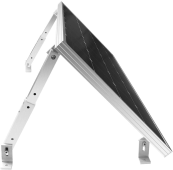
NOT MY PICTURE, NOT MY WORK
That is a PRODUCTION solution, this that I am working on is a PROTOTYPE. A prototype never looks like the final production! If it does, then you are getting ahead of yourself. A good prototype can be built from parts off the shelf at a hardware store.
Eh hem
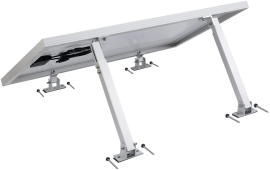
KISS
Keep It Simple Stupid, RIGHT?
No need for the mounting system to cost more than the panels! Grrrrr......

Something like the above is clearly over-engineered. You just do not need that much support. It wont hurt, but it is very costly and unwarranted. That is probably rated to hold more snow than the face of the panels can hold.

Fine solution there, but my panels are not going to be going 80MPH.
* Wind
* Snow
* Hail
* Earthquake
Cut that down
* Wind
* Earthquake
Get the cases grounded together really well, get that back to the inverter. Set up the ground fault.
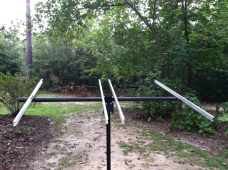
We are not trying to build Fort Knox here. What we seek is MVP for a safe setup. YEA... in the most extreme conditions, you may lose a panel or two. That is better than pricing out 99% of the public.
Working on it man. . . working on it.
It is like they are trying to make Solar like School... if you want to have it, then you must be a Debt Slave.
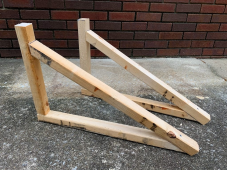
Nothing wrong with that. Those are 4x4's man. That is heavy timber!
When you are building something Temporary, Portable, and Modular you MUST go LIGHT.
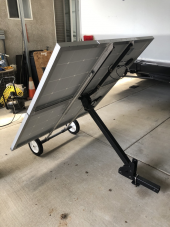
Adding weight to something is not always the best solution. Keeping something strong and stiff... does not require weight and claptrap.
I could probably leverage 5lbs of Carbon Fiber kite spars to build a mount that would out-perform every "Qualified" mount on the market. Just a matter of allowing flex where flex is needed. . . and being stiff where stiff is needed.
Built a lot of things that fly 190mph
I can tell you that it does not happen by adding more and more steel. You ever ride in a 737? How much steel do you think they use in that bird? How much Aluminum? How many composites?

Its an old design, but a good one. We are moving on now.
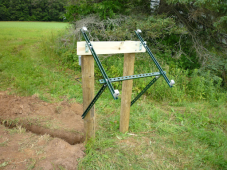
Look at that, thats great
You have to think to yourself things like
* How will this scale
* How specific to this implementation is this solution?
* What if I have to change panel shape and size?
* How can I incorporate COTS (high volume) brackets and stuff?

I have a whole set of proper brackets in transit (from Signature Solar, so far those guys are great). What you are going to see me do today is a setup for EVALUATION.
Right?
EVALUATE - .>>> BEFORE
You commit to a mounting angle. You may be WICKED SUPRISED at how little you get out of your panels. Half easy. You can easily get HALF your rated output if you dont take the time to "fiddle a bit"
Bit Fiddling - K?
Experiment - if even with just one panel... if even with just an old 100W. Get up there, try it out, check your assumptions, take measurements.
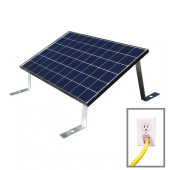
Just keep looking at how everyone else did it. Eliminate as much clap-trap as you can.
* Materials Cost
* Cost of working the material
* Build time
* Teardown time
Many seemingly clever solution are horrific at time of install. Fugging fiddle bits like nuts and bolts and washers falling all over the place. TAKE EXTRA, because your gutter is going to be full of loose hardware
LOL
Rigged so much crap in my life. I used to forward WiFi over miles distance by putting up repeaters on roofs. This is far heavier, so we have to take extra precaution. I had the wind blow a lawn chair right off my roof just a couple months ago.
* Flat Roof
* Plastic lay-back lawn chair (heavy one)
* Blew right off the roof, into the front yard
So remember that!
Wind picks up something FIERCE... so account for it, or have a system that collapses quickly. Anchoring is important, but Sandbags are not welcome up on the roof. You basically MUST fasten down.
Like on a boat... tie it down or its gone.
-methods
-methods
* Nema Rated Materials, non flammable
* Basically mounted right on the ground
* Bottom held off by a few inches for clearances

NOT MY PICTURE, NOT MY WORK
That is a PRODUCTION solution, this that I am working on is a PROTOTYPE. A prototype never looks like the final production! If it does, then you are getting ahead of yourself. A good prototype can be built from parts off the shelf at a hardware store.
Eh hem

KISS
Keep It Simple Stupid, RIGHT?
No need for the mounting system to cost more than the panels! Grrrrr......

Something like the above is clearly over-engineered. You just do not need that much support. It wont hurt, but it is very costly and unwarranted. That is probably rated to hold more snow than the face of the panels can hold.

Fine solution there, but my panels are not going to be going 80MPH.
* Wind
* Snow
* Hail
* Earthquake
Cut that down
* Wind
* Earthquake
Get the cases grounded together really well, get that back to the inverter. Set up the ground fault.

We are not trying to build Fort Knox here. What we seek is MVP for a safe setup. YEA... in the most extreme conditions, you may lose a panel or two. That is better than pricing out 99% of the public.
Working on it man. . . working on it.
It is like they are trying to make Solar like School... if you want to have it, then you must be a Debt Slave.

Nothing wrong with that. Those are 4x4's man. That is heavy timber!
When you are building something Temporary, Portable, and Modular you MUST go LIGHT.

Adding weight to something is not always the best solution. Keeping something strong and stiff... does not require weight and claptrap.
I could probably leverage 5lbs of Carbon Fiber kite spars to build a mount that would out-perform every "Qualified" mount on the market. Just a matter of allowing flex where flex is needed. . . and being stiff where stiff is needed.
Built a lot of things that fly 190mph
I can tell you that it does not happen by adding more and more steel. You ever ride in a 737? How much steel do you think they use in that bird? How much Aluminum? How many composites?
Its an old design, but a good one. We are moving on now.

Look at that, thats great
You have to think to yourself things like
* How will this scale
* How specific to this implementation is this solution?
* What if I have to change panel shape and size?
* How can I incorporate COTS (high volume) brackets and stuff?

I have a whole set of proper brackets in transit (from Signature Solar, so far those guys are great). What you are going to see me do today is a setup for EVALUATION.
Right?
EVALUATE - .>>> BEFORE
You commit to a mounting angle. You may be WICKED SUPRISED at how little you get out of your panels. Half easy. You can easily get HALF your rated output if you dont take the time to "fiddle a bit"
Bit Fiddling - K?
Experiment - if even with just one panel... if even with just an old 100W. Get up there, try it out, check your assumptions, take measurements.

Just keep looking at how everyone else did it. Eliminate as much clap-trap as you can.
* Materials Cost
* Cost of working the material
* Build time
* Teardown time
Many seemingly clever solution are horrific at time of install. Fugging fiddle bits like nuts and bolts and washers falling all over the place. TAKE EXTRA, because your gutter is going to be full of loose hardware
LOL
Rigged so much crap in my life. I used to forward WiFi over miles distance by putting up repeaters on roofs. This is far heavier, so we have to take extra precaution. I had the wind blow a lawn chair right off my roof just a couple months ago.
* Flat Roof
* Plastic lay-back lawn chair (heavy one)
* Blew right off the roof, into the front yard
So remember that!
Wind picks up something FIERCE... so account for it, or have a system that collapses quickly. Anchoring is important, but Sandbags are not welcome up on the roof. You basically MUST fasten down.
Like on a boat... tie it down or its gone.
-methods
-methods
methods
New Member
- Joined
- Dec 6, 2021
- Messages
- 173
How to Anchor in a Storm?
When you are BUSH MOBILE you use tethers. You dont go anchoring into everything, you TETHER things. In that event, if the wind gets strong enough, the panels will wind vane and you will be fine.
Understand?
* Single point of attachment that pre-exists
* Tether to a single point, low, on the high pole
Wind starts blasting hard, yea... things will slide around a bit. Not that much tho, not enough to fly off the roof. Just... set your standard.
* Shifting? OK
* Flying off the roof? NOT OK
* Causing Hazard? NOT OK
So figure out what that means. Put safety's in place. I am the kind of guy who builds a system that will "SNAP TO OFF" or "SNAP TO SAFE" and only stays "ON" thru a series of interlocks that keep it so.
* Winds must be lower than X
Got it?
Small wind vane, feeds into a Microcontroller, microcontroller measures wind speed, keeps heartbeat going.
LOGIC
* IF heartbeat, keep system on
* IF any breach, blow safety breaker
It is the most basic of "FAIL FAST" you can build and it allows you to do things differently than you are used to seeing. Just look at modern cars that have a CAN throttle etc. All of these work on a heartbeat principle.
Its called a Safety System, or safety sub-system
Doing this can alleviate the hazards that gross over-engineering usually manages. You change your limits. LIke...
* It is ok if the panel goes over
* BUT
* It must be de-energized
For things like that you can use Bootstrap switches, mercury switches, etc. Very easy to set up, very reliable. The most dangerous things in the world rely on systems like these.
-methods
When you are BUSH MOBILE you use tethers. You dont go anchoring into everything, you TETHER things. In that event, if the wind gets strong enough, the panels will wind vane and you will be fine.
Understand?
* Single point of attachment that pre-exists
* Tether to a single point, low, on the high pole
Wind starts blasting hard, yea... things will slide around a bit. Not that much tho, not enough to fly off the roof. Just... set your standard.
* Shifting? OK
* Flying off the roof? NOT OK
* Causing Hazard? NOT OK
So figure out what that means. Put safety's in place. I am the kind of guy who builds a system that will "SNAP TO OFF" or "SNAP TO SAFE" and only stays "ON" thru a series of interlocks that keep it so.
* Winds must be lower than X
Got it?
Small wind vane, feeds into a Microcontroller, microcontroller measures wind speed, keeps heartbeat going.
LOGIC
* IF heartbeat, keep system on
* IF any breach, blow safety breaker
It is the most basic of "FAIL FAST" you can build and it allows you to do things differently than you are used to seeing. Just look at modern cars that have a CAN throttle etc. All of these work on a heartbeat principle.
Its called a Safety System, or safety sub-system
Doing this can alleviate the hazards that gross over-engineering usually manages. You change your limits. LIke...
* It is ok if the panel goes over
* BUT
* It must be de-energized
For things like that you can use Bootstrap switches, mercury switches, etc. Very easy to set up, very reliable. The most dangerous things in the world rely on systems like these.
-methods
methods
New Member
- Joined
- Dec 6, 2021
- Messages
- 173
Yep
Any given panel will continue to be energized by sun - tho - probably not all that much around here. Here, with wind comes poor sun conditions.
BUT
What you can do is break up the sum-voltage. 50V is not anything to worry about. 500V is.
SO
YOu ask yourself
What is the ark flash limit?
Ok, to find out, you just start wiring panels in series and sparking the ends off. Probably see a good rip around 100V and up. Depends on how much inductance you have in the system.
How do you manage it?
* Snap to short circuit (easiest)
* Snap to open circuit (requires gas filled contactor)
For the following we will be using $20 (in volume) Gigavac minitactors. They are rated for 2000V and about 50A. They do their job well. You can switch solar in and out, all day long on those... so long as you are not wicked-hitting a capacitive input. Even if you are, you can final pre-charge thru a boot-strap resistor. This is an NC relay that goes open at time of inrush.
-methods
Any given panel will continue to be energized by sun - tho - probably not all that much around here. Here, with wind comes poor sun conditions.
BUT
What you can do is break up the sum-voltage. 50V is not anything to worry about. 500V is.
SO
YOu ask yourself
What is the ark flash limit?
Ok, to find out, you just start wiring panels in series and sparking the ends off. Probably see a good rip around 100V and up. Depends on how much inductance you have in the system.
How do you manage it?
* Snap to short circuit (easiest)
* Snap to open circuit (requires gas filled contactor)
For the following we will be using $20 (in volume) Gigavac minitactors. They are rated for 2000V and about 50A. They do their job well. You can switch solar in and out, all day long on those... so long as you are not wicked-hitting a capacitive input. Even if you are, you can final pre-charge thru a boot-strap resistor. This is an NC relay that goes open at time of inrush.
-methods
methods
New Member
- Joined
- Dec 6, 2021
- Messages
- 173
Solid State?
Of course. Any number of IGBT's will get the job done. Gotta be a bit more careful with those, but they will work. Lots of TVS diodes and attention to polarity with that solution. They are NOT friendly to back-voltage. In reverse bias they will self destruct... so you have to run two back to back.
Totem Pole setup
Basis over every BMS that has Charge and Discharge on the same lines. Eh hem.
Onward.
Of course. Any number of IGBT's will get the job done. Gotta be a bit more careful with those, but they will work. Lots of TVS diodes and attention to polarity with that solution. They are NOT friendly to back-voltage. In reverse bias they will self destruct... so you have to run two back to back.
Totem Pole setup
Basis over every BMS that has Charge and Discharge on the same lines. Eh hem.
Onward.
methods
New Member
- Joined
- Dec 6, 2021
- Messages
- 173
OK - GO
T-Start 0728 PDT
* Build MVP to assess feasibility of an interlocked safety system that will allow for temporary install of solar panels
... As soon as I have Proof of Concept on that, I will move out to the target location. I have archers of fire-cleared land to work on. Not a fire hazard in 100 yards.... thanks to lack of maintenance by the community as a whole. Weeds... yes, so that will have to be accounted for. Underlayment of course!
Bushes and trees? NO
Lots of sand? YES
Remember that what we are doing is setting up TEMPORARY rigs. Not "till the end of time" permanent, you guys have that nailed. What I am doing is a "Pop Up Venue" version.
* Store it
* Transport it
* Set it up
* Use it
* Break it down
* Transport it
* Store it
Like that. Military does nothing BUT that... so it is not like it is a new idea (lol).
-methods
T-Start 0728 PDT
* Build MVP to assess feasibility of an interlocked safety system that will allow for temporary install of solar panels
... As soon as I have Proof of Concept on that, I will move out to the target location. I have archers of fire-cleared land to work on. Not a fire hazard in 100 yards.... thanks to lack of maintenance by the community as a whole. Weeds... yes, so that will have to be accounted for. Underlayment of course!
Bushes and trees? NO
Lots of sand? YES
Remember that what we are doing is setting up TEMPORARY rigs. Not "till the end of time" permanent, you guys have that nailed. What I am doing is a "Pop Up Venue" version.
* Store it
* Transport it
* Set it up
* Use it
* Break it down
* Transport it
* Store it
Like that. Military does nothing BUT that... so it is not like it is a new idea (lol).
-methods
methods
New Member
- Joined
- Dec 6, 2021
- Messages
- 173

based on

Where yesterday we calculated optimal height of 32 - 34 inches vertical
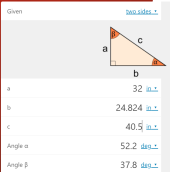
So angle B works out to 37.8 degrees. If that were 45 degrees, then our leg length would be the same as our width (c).
90 - 37.8 = 52.2 degrees
That is the angle we need for this particular proof
Now back-calculate the resultant, unshown triangle.... You could do that all day. While you do that, I am going to go directly measure it with a tape measure
-methods
Similar threads
- Replies
- 29
- Views
- 1K
- Replies
- 28
- Views
- 1K
- Replies
- 0
- Views
- 85



